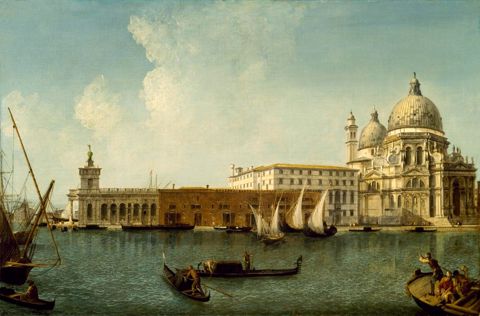Lost Treasure of the Jewish Ghetto of Venice. Restored by Venetian Heritage Inc.

Michele Marieschi, View of the Dogana and Santa Maria della Salute, Venice, c. 1740, oil on canvas, Sarah Campbell Blaffer Foundation.
Venetian, One of a Pair of Vegetable Plates, early 20th century, silver, Collection of the Comunità Ebraica di Venezia (The Jewish Community of Venice).
Italian, Torah Crown, mid-19th century, parcel-gilt silver, Collection of the Comunità Ebraica di Venezia (The Jewish Community of Venice).
Italian, probably Venice, Torah Case, 18th century, giltwood and fabric, Collection of the Comunità Ebraica di Venezia (The Jewish Community of Venice).
Italian, One of a Pair of Rimmonim, 18th century, silver, Collection of the Comunità Ebraica di Venezia (The Jewish Community of Venice).
Italian, probably Venice, Hanging Lamp, 1804, silver, Collection of the Comunità Ebraica di Venezia (The Jewish Community of Venice).
When Nazis invaded Italy in September 1943, two elderly Jewish religious leaders responded to the disastrous news by hiding a cache of 17th- to 20th-century silver and bronze liturgical works in a secret hiding place within a Venetian synagogue. The treasures remained untouched for more than 60 years, until they were accidentally discovered. Lost Treasure of the Jewish Ghetto of Venice. Restored by Venetian Heritage Inc. features the restored silver and bronze pieces complemented by Venetian paintings from the same period. The exhibition is on view at the Museum of Fine Arts, Houston, February 21 through April 28, 2013.
Jewish residents, though segregated, played a valuable role in the economy of Venice from the time of the Renaissance. In 1516, the Venetian Senate established a residential area exclusively and mandatorily for Jews on the grounds of a former foundry (geto), claiming the Jews could not be allowed to live all over the city or in the same houses as Christians. The six-acre, entirely enclosed ghetto housed several thousand people and contained five major synagogues.
Made by master craftsmen using traditional silversmithing and bronze casting methods, the objects in Lost Treasure of the Jewish Ghetto of Venice are predominantly liturgical works used in Venetian synagogues during worship services and special holiday events. The pieces represent an in-depth look at Venetian Jewish silver from the 17th to early 20th centuries.
Some objects that relate to dining traditions include the ewer (washing cup) and basin, used for the washing of hands prior to eating, and two vegetable plates, used during Passover Seders. Liturgical pieces include the wooden tikim (Torah cases), which stored the Torah scrolls when they were not in use, and the grand Torah crowns and pairs of rimmonim (silver pomegranates) that adorned the tops of either the scrolls or tikim. Hanging above each tik is a lamp called a Ner Tamid (Eternal Light) that illuminates the tik or a larger Ark in a synagogue. Two spice containers, used in the Havdallah service at the closing of the Sabbath to bring worshippers back to reality from the ecstasy of Shabbat, are also featured along with two yads (pointers to help readers follow text in the Torah) used during services.
In 2016, the Jewish Ghetto of Venice will celebrate its 500th anniversary. Looking forward to this anniversary, the international organization Venetian Heritage Inc., with the support of Maison Vhernier, organized this special exhibition. The presentation of these treasures in Houston has been augmented with Venetian paintings from the same period drawn from a private collection and the collections of the Museum of Fine Arts, Houston, and the Sarah Campbell Blaffer Foundation.
This exhibition is organized by Venetian Heritage Inc. and the Museum of Fine Arts, Houston, in collaboration with the Sarah Campbell Blaffer Foundation. The objects were restored with the support of Maison Vhernier.
Generous funding is provided by:
Joan and Stanford Alexander
Julie and Drew Alexander in honor of Joan and Stanford Alexander and Davna and Edward Brook
Joyce Z. Greenberg
Barbara and Gerry Hines
Shirley Toomim;
Cyvia and Melvyn Wolff
Helaine and David Lane
Jeri and Marc Shapiro
Nancy and Scott Atlas
Nancy Beren and Larry Jefferson
Paula and Irving Pozmantier
Regina Rogers in honor of Holocaust survivor Stefi Altman
Glen Rosenbaum
Shirley and Marvin Rich.
The MFAH curators are Cindi Strauss, curator of Modern & Contemporary Decorative Arts and Design, and James Clifton, director of the Sarah Campbell Blaffer Foundation and curator of Renaissance and Baroque Painting.
